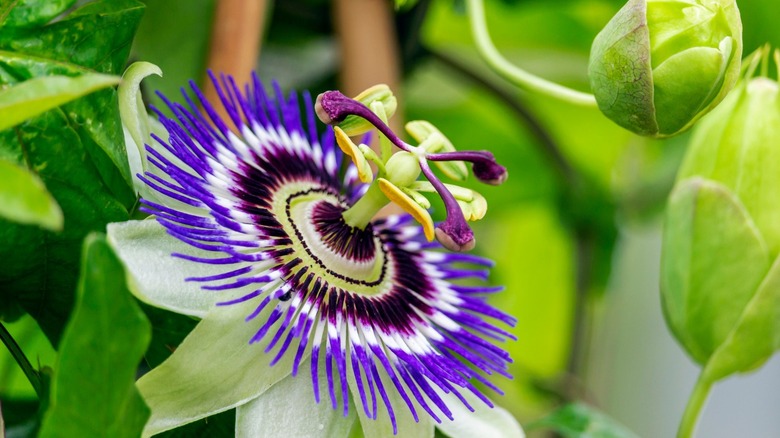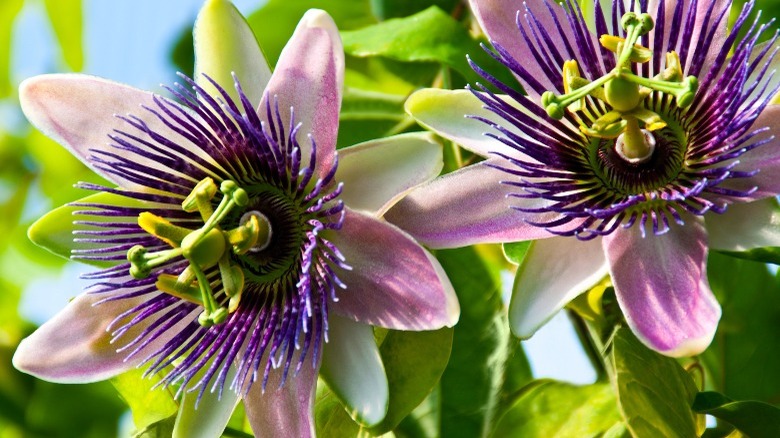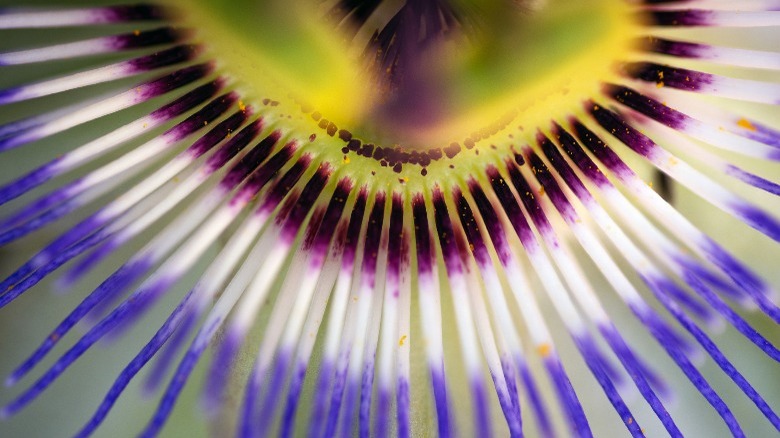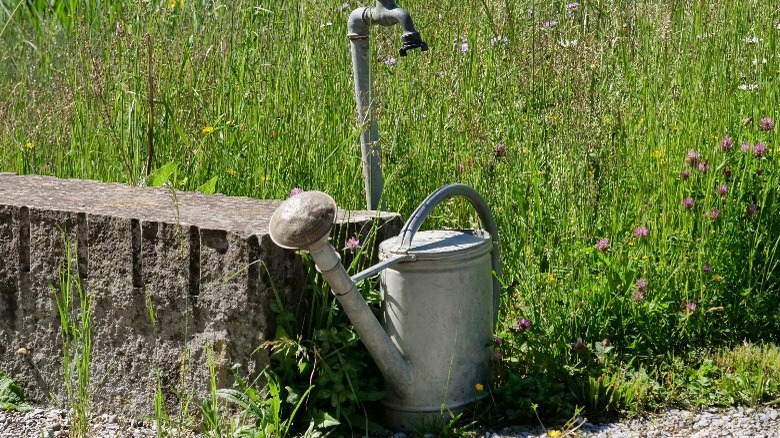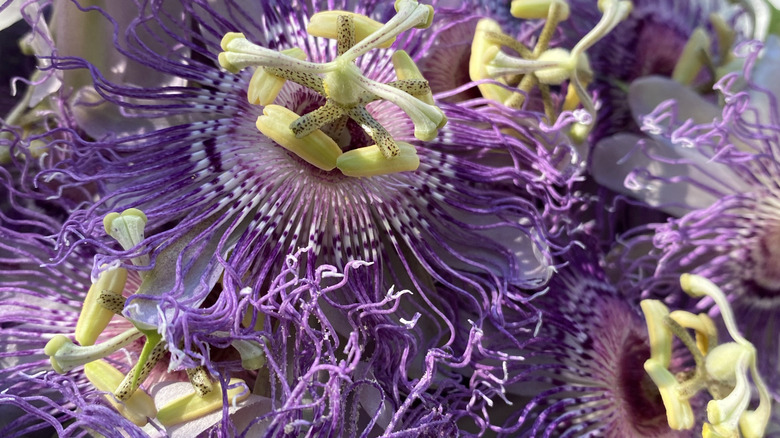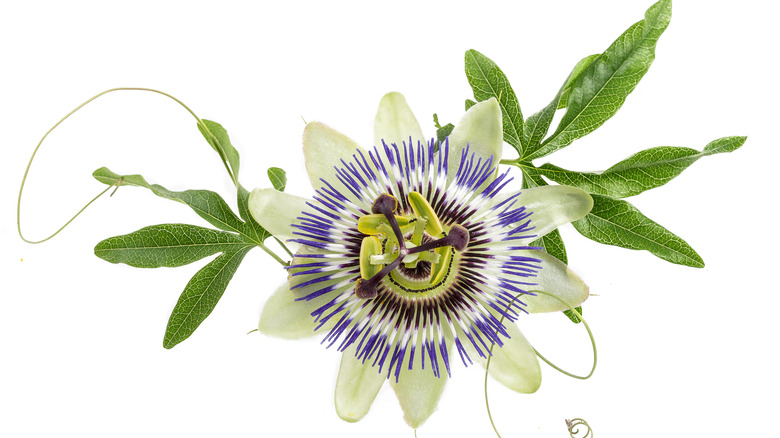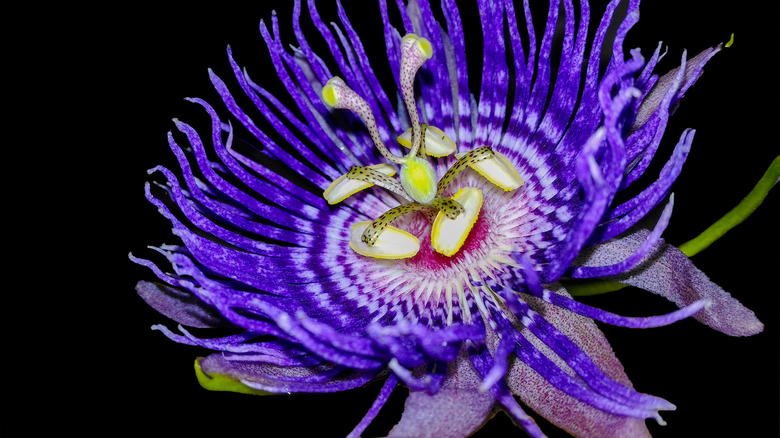How To Successfully Grow And Care For Passion Flowers
Passion flowers, also known scientifically as passiflora, are part of the hundreds of species found in the passifloraceae family. They are commonly found in the southern parts of North America as well as throughout South America. According to Plants in Motion, they're originally native to the Asia, Australasia, and Polynesian Island regions. Due to these one of a kind plants originating and growing in various locations, they can be grown almost anywhere in the world and in many different ways.
The Spruce shares that passion flowers can come in many shapes, sizes, and colors. Furthermore, there are actually several different variants of passion flowers. Therefore, the name passion flowers can actually mean several kinds of blooms. Most tend to bloom in the spring and throughout the summer and fall. Depending on the variant, they can reach anywhere from 6 feet up to around 30 feet tall, and typically grow 3 to 6 feet wide. Uniquely, these flowers have a wide petal base that only stays open for a day.
How to use passion flowers in garden
There are many different ways and places where passion flowers can be grown. One of those areas is a garden in USDA hardiness zones 7 through 10. However, growing passion flowers in a garden must be done very carefully. Having so many variants, it's best to know exactly which passion flower is being planted and where the exact location of the flower is going to be. Since some passion flowers tend to have vines, Gardening Know How suggests planting those along a fence, wall, archway, or any area where they can essentially climb.
For other variants, take into consideration the height that the specific type of flower is going to reach. This is important if there are any power lines or other objects above the planting location. Likewise, with all passion flowers, make sure to be cautious of any pipe or other inground objects that can be in the way of or cause damage to the plants. Since they can spread up 6 feet wide, it's wise to keep at least this amount of distance or further away from all other plants within the garden.
How to grow passion flowers
Growing passion flowers is actually easier than one might think. For starters, Gardening with Charlie Nardozzi states that the best time to plant passion flowers is during the spring for both seeds and beginner plants. Additionally, they should be grown in direct sunlight if possible. Partial sunlight is okay, but the more sunlight these flowers have, the quicker they are to grow. Like with any plant, passion flowers need to be watered immediately after the initial planting.
Depending on location, some winters can become much too harsh for passion flowers to survive. Due to this, they tend to need much more protection against the strong cold weather than most other plants. Luckily, passion flowers can not only be grown outdoors, but inside as well. Much like the steps to growing outdoors, passion flowers can be planted in a big pot with moist soil. Gardening Know How suggests placing the plant in front of a bright lit window and taking the pot outdoors when the winter has passed.
How to care for passion flowers
Passion flowers are relatively easy to care for. After watering during the planting period, they only require water once or twice a week. Typically, they just need enough water to keep the soil moist at all times. The Spruce warns that around 1 inch to 1 1/2 inches of water is how much passion flowers should get on a weekly basis if no rain has fallen that week. This is extremely crucial to make sure the flowers don't get dehydrated.
However, just like any other plant, passion flowers tend to start to die out from time to time. This can be noticed if the flower is starting to fall downwards into a slumping shape and the leaves are turning to a shade of brown. If this does happen, Garden Guides suggests checking on how much water, sunlight, and fertilization the flower is getting. Usually, adding a little bit more to the flower is enough to make it bloom again.
Passion flower varieties
Many flowers have a ton of different offspring varieties, and passion flowers aren't any different. Garden Guides suggests choosing a variant based on color, size, location, and intended use for the plant. Without further ado, here are a few colorful options:
-
Red passion flower: The red passion flower is, well, red. Scientifically known as Passiflora Caerulea, this flower can grow to an average of around 12 feet. Usually, red passion flowers bloom in the late summer to early fall.
-
Blue passion flower: Scientifically, the blue passion flower is known as Passiflora Coccinea. This flower specifically can range anywhere from 10 feet all the way up to 30 feet tall. Usually, blue passion flowers reach the peak of their bloom period in late summer.
-
Yellow passion flower: Yellow passion flowers, scientifically known as Passiflora Lutea, can grow up to about 3 feet in length. Usually, these flowers bloom in early summer and can last up until late summer and sometimes the beginning of fall.
- Wild passion flower: Wild passion flowers are scientifically known as Passiflora Incarnate. Unlike others, these flowers usually only reach a peak height of 8 inches tall. Their blooming period typically happens midsummer through late summer or early fall.
Are passion flowers toxic?
Passion flowers are indeed somewhat toxic. The leaves and vines of passion flowers can be extremely poisonous to animals and insects. According to Science Wanders, their leaves and vines contain certain chemicals such as cyanide. When combined with another chemical, a toxin can be released whenever the leaf is disrupted. It should be noted that touching the leaf itself doesn't cause any harm, therefore, passion flowers aren't usually toxic to humans. However, if an animal or insect goes to take a bite, they will be poisoned.
Luckily, passion flowers are not usually deadly. Typically, the worst case scenario for a pet is an upset stomach. If symptoms don't improve within a few days, see a vet for further evaluation. If a person comes into contact with the toxin released from the leaves and vines of passion flowers, wash hands thoroughly immediately. In conclusion, it's best just to keep all pets a safe distance from these flowers to prevent any unfortunate incidents.
How to replant passion flowers
When replanting passion flowers, usually one can follow the same steps as the original planting. However, there are a few more things to consider than before. First, like with any plant, digging up and replanting a species makes it more vulnerable and fragile. To do so correctly, the flower must be handled very delicately. For starters, make sure to plan weeks in advance as to when exactly the flowers need to be replanted. Gardening Know How warns to not fertilize passion flowers six to eight weeks before the replanting.
Furthermore, it may be easier to trim the flowers and their vines to allow for a smoother and easier transition. From here on out, the original planting routine of passion flowers can be followed. Just remember that these flowers need a good amount of water to stay hydrated and as much sunlight as possible. It's best to keep a close eye on replanted flowers until they're fully established.
How to use fertilizer with passion flowers
While passion flowers can be self-fertilizing, they still need some help as well. SFGate suggests the best fertilizer to get is one that has potassium, nitrogen, and phosphorus chemicals included. Furthermore, they suggest fertilizer marked with low numbers such as 4-4-4. Higher numbers such as 8-8-8 or above are strongly not recommended as they can and most likely will cause damage to the plant.
However, just like with water, do not over fertilize passion flowers. Yet, don't under fertilize either; the plant must be kept at an equal balance of both. Garden Beast recommends fertilizing passion flowers early in the spring; usually, this should be four to six weeks before they begin to bloom. Furthermore, they should be fertilized every four to six more weeks throughout the rest of the spring, the entire summer, and into the fall. Fertilizing can stop once the passion flowers begin to die off, usually when the weather begins to cool off.
